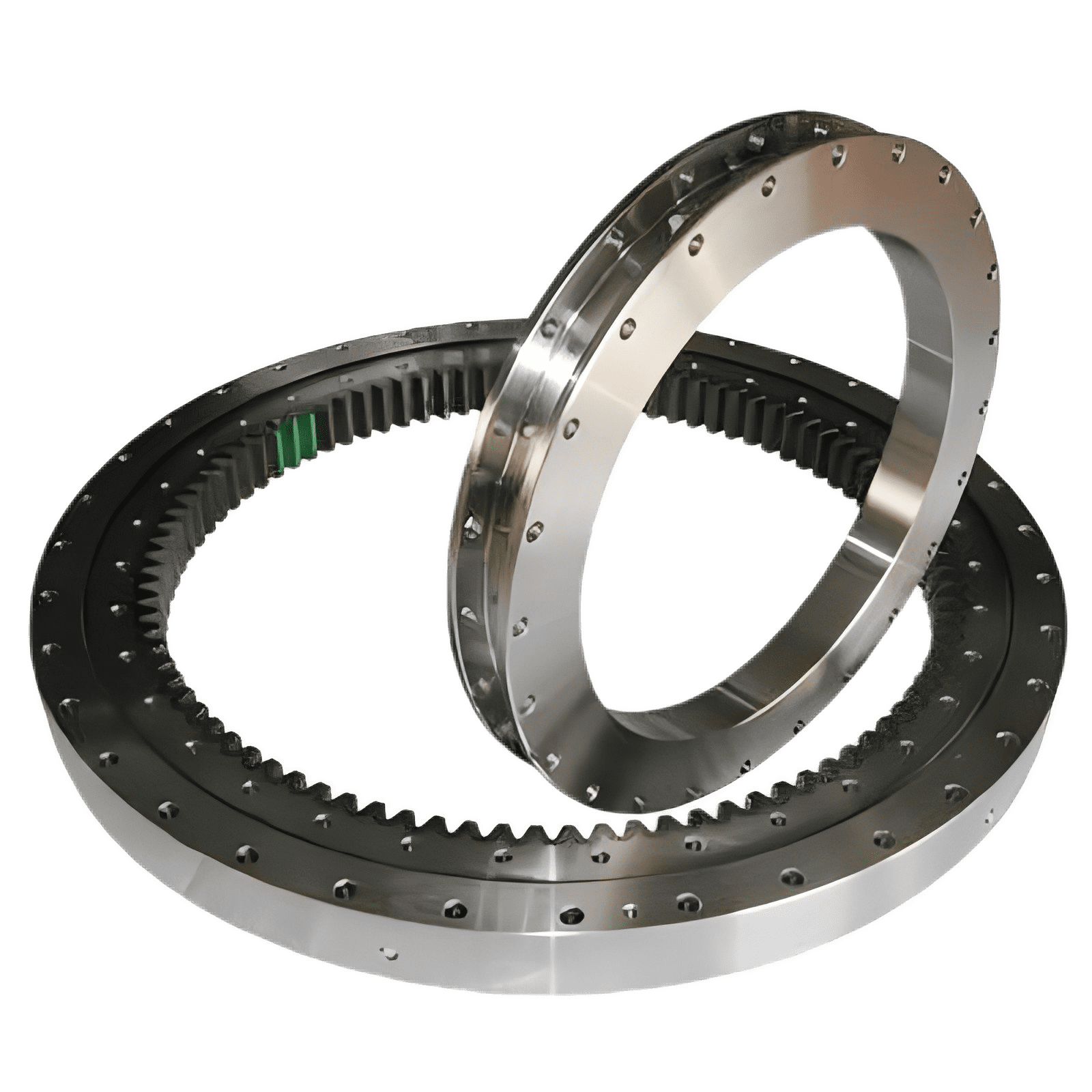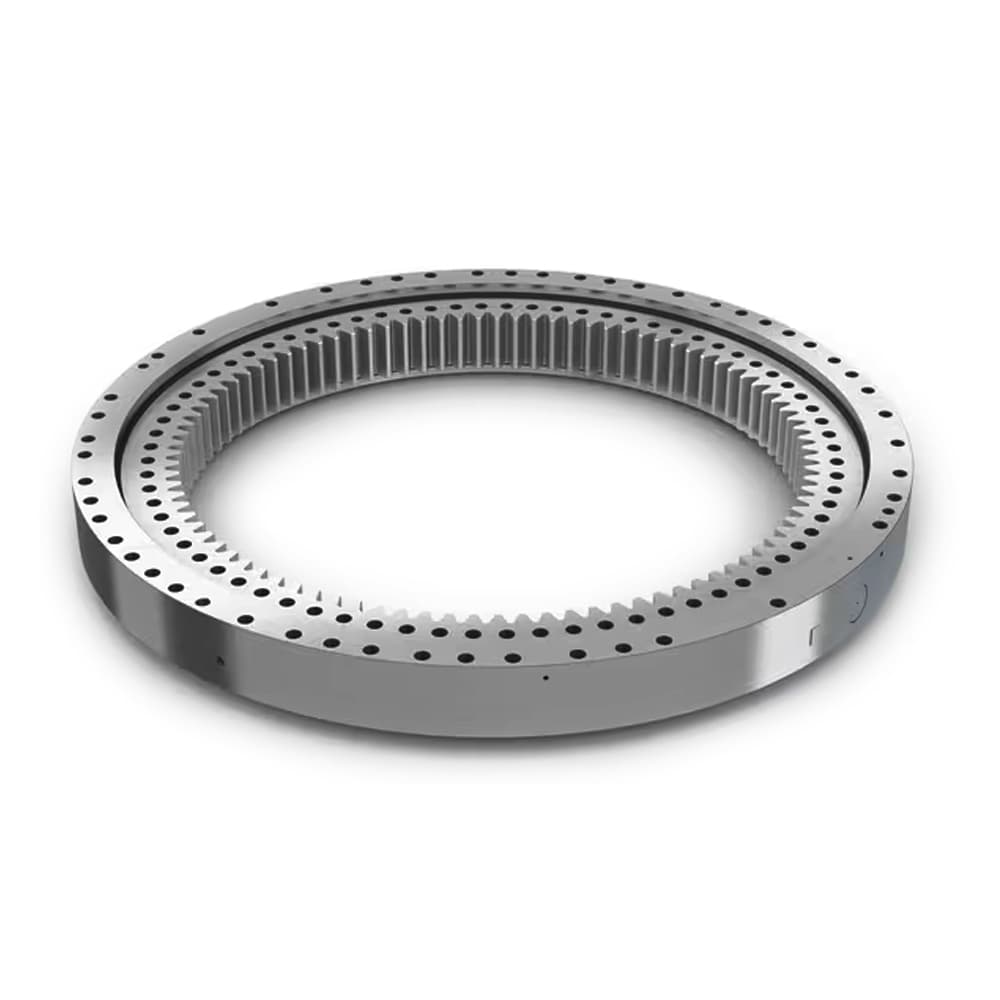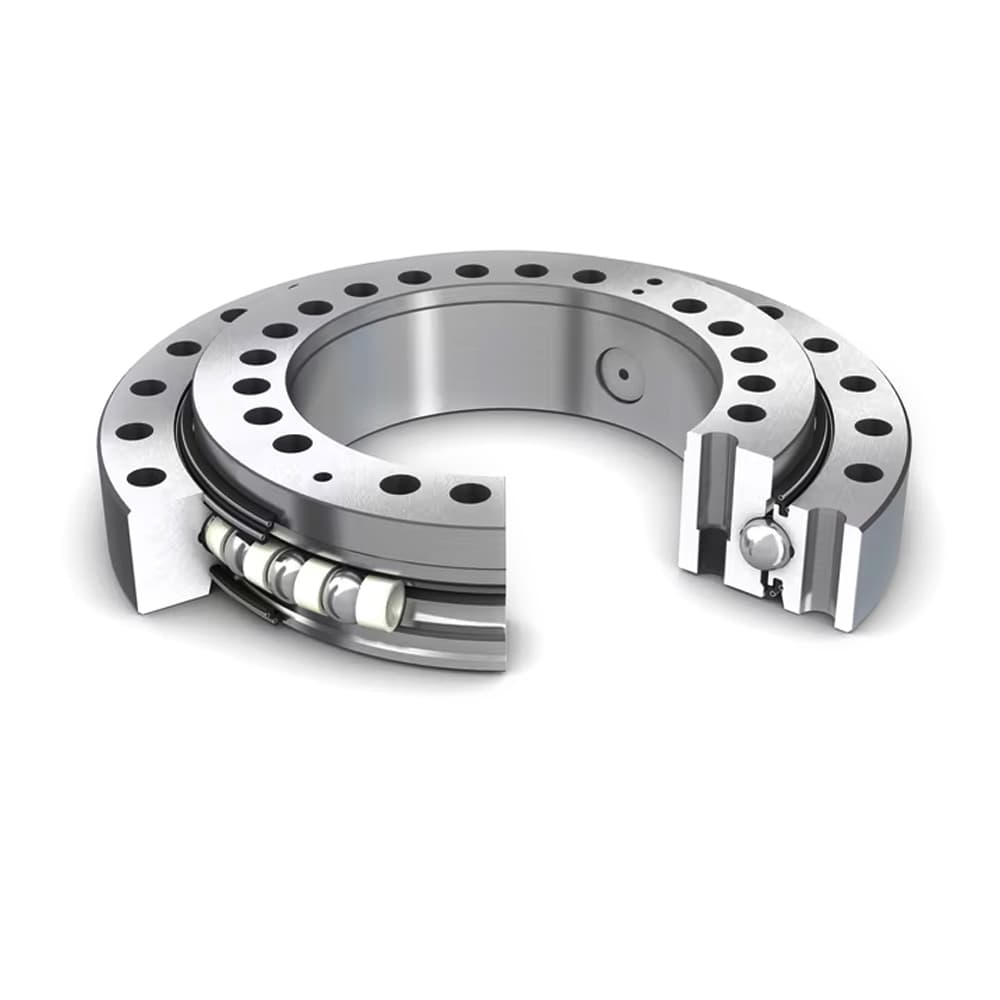What is the Maintenance on a Slewing Ring Bearing?
Acting as the key "hinges" in large machines like cranes and excavators, slewing ring bearings enabled them to rotate smoothly and with precision. These bearings can manage a wide range of loads, including thrust, radial, and tilting moments.
Keeping these bearings in good condition isn't just important—it's essential for their long life and top performance. If you don't do routine maintenance for them, they might cause your machines to stop working, need expensive fixes, or even be unsafe when you're using heavy machinery.

Key Maintenance Practices for Slewing Ring Bearings
Regular Lubrication
To keep running smoothly, slew bearings need the right kind of grease. The choice depends on how and where the machine is used.
There's lithium complex grease for everyday jobs, polyurea for hot and heavy work, aluminum complex for wet places, and synthetic greases for very hot or cold conditions. EP greases give extra protection under heavy loads, and food-grade greases are perfect for the food industry. For cold places, there's special low-temperature grease.
Following the maker's advice on using grease is key to keeping the turntable bearing lasting long periods.

Lubrication Schedule
A good rule of thumb for lubrication is to do it every 100 hours of operation. But if the machine runs at high speed or works in tough conditions, it might need more frequent lubrication. Always check what the machine's maker suggests for best results.
Lubrication Procedure
Proper lubrication of a slew bearing is crucial for its longevity and high performance. Here is a step-by-step guide on how to add grease to bearings correctly:
Preparation:
- Ensure the bearing is clean and free of any old grease or debris.
- Check the bearing's manual for the recommended type and quantity of grease.
Grease Selection:
- Use the grease specified by the bearing manufacturer.
- Consider the operating conditions such as temperature range and load.
Grease Application:
- Apply the grease using a grease gun or a similar tool.
- Insert the grease into the bearing's grease fittings, ensuring even distribution.
Lubrication Points:
- Locate all the grease nipples or fittings on the bearing.
- Make sure to lubricate all points to avoid uneven distribution.
Rotation: Rotate the bearing while applying grease to help distribute it evenly within the bearing.
Grease Quantity:
- Fill the bearing with grease until starting to expel from the seals or other outlets.
- Avoid overfilling, as this can cause excessive pressure and damage the seals.
Wiping Excess: Wipe off any excess grease around the grease fittings to prevent dirt.
Post-Lubrication Rotation: After lubrication, rotate the bearing several times to ensure the grease is spread evenly.
Clean Up: Clean up any spilled grease to maintain a clean working environment.
Maintenance Schedule: Follow the manufacturer's recommended maintenance schedule for future lubrication.
Record Keeping: Keep a record of the lubrication date and the type of grease used for future reference.
Inspection and Monitoring
Visual Inspection
Regular visual inspections of slewing rings are vital to spot problems early, like cracks, broken seals, rust, and wear. These problems that can cause equipment failure if not fixed.
During maintenance inspection, look for signs of damage, check seal integrity, assess corrosion and lubricant condition, and how everything is lined up. Also, watch out for anything that's too loose or swollen. Keep things clean to stop wear from dirt. Address any findings promptly to avoid further damage.
By checking the bearings regularly, you can prevent unexpected downtime, extend the bearing's life, ensure safety, and maintain performance.
Noise and Vibration Monitoring
Strange noises and vibrations might be signs that there's an issue with the bearings. This could be due to misalignment, insufficient lubrication, or wear and tear. If you hear a squealing sound, it could mean that the bearing needs more lubrication. A grinding noise could mean the parts are rubbing together because they're worn. Paying attention to these signs is crucial to fix things before they get worse.
Bearing Health Monitoring Techniques
- Vibration Analysis: Use vibration analyzers to closely examine the vibrating patterns, which can tell you how well the bearings are doing.
- Thermal Detection: Use infrared cameras to find hot spots that could show friction-related or other bearing concerns.
- Ultrasonic Inspection: Use ultrasonic detectors to listen for high-pitched sounds that could signal bearing defects.
- Acoustic Emission Monitoring: Some hidden flaws in the material could affect bearing integrity. Use special sensors that record stress waves to find them.
- Lubricant Assessment: Conduct regular lubrication analysis to gain insights into the operational condition of your bearings.
- Component Balancing: Keep parts spinning smoothly with balancing equipment to reduce vibrations and extend bearing life.
- Data Logging: Use tools that keep a record of what's happening over time. In this way it will be easier to spot patterns and catch possible bearing issues before they become big problems.
- Essential Maintenance: Adopt these tools and methods a key part of looking after your equipment. This way, you can keep your bearings working reliably and make them last longer.
Clearance Measurement
Checking how much a bearing can tilt is important to see if a slewing bearing is wearing out. When a bearing gets worn out, it may result in increased tilt. This could lead to poor performance and failure.
Follow the steps to measure clearance:
- Apply a defined tilting moment to the bearing and use a dial gauge to see how much it moves;
- Then compare this number to what the bearing supplier says it should be or to the number from when it was new.
If the space for tilting increases gets bigger than it should, it means the bearing is worn and might need maintenance or replacement.
Clearance measurement prevents unexpected equipment breaking down and makes sure everything runs safely.

Bolt Tightening and Inspection
- Importance of Proper Bolt Tightening of slewing bearings:
Proper bolt tightening ensures even load distribution and prevents misalignment. If the bolts are not tight enough, it can cause issues like the bearing race deformation, increased friction, and ultimately, bearing failures.
Use a special tool called a torque wrench and follow the right order for tightening the bolts. This makes sure the bolts are as tight as they should be, which helps the bearing stay in good shape and last longer. This practice is crucial for the reliable operation of machinery and the safety of personnel.
- Bolt Inspection Schedule:
Once your machine has run for 100 hours, check the bolts on the slewing bearing and make sure they're as tight as the maker recommends. Use the right amount of torque when you do this. After that, check them every 500 hours or once a year, whichever happens sooner.
If you see any bolts signs of fatigue, such as thread wear, elongation, or corrosion, replace them right away. Always use the correct grade and length of bolts and follow the recommended tightening sequence.
Seal Inspection and Replacement
Role of Seals in Bearing Protection
Seals on slewing bearings form a shield to protect bearing internal components against dirt and debris. They also create a seal with the bearing housing, helping to retain lubricant and maintain optimal operating conditions.
Check the seals regularly to ensure they're working well.
Seal Inspection Process
Regular Inspection: Conduct routine checks for any cuts, cracks, or deformation in the seals.
- Attachment Verification: Ensure seals are correctly attached and are not excessively worn.
- Replacement Protocol: Replace seals that are damaged or exhibiting leakage signs.
- Cleanliness: Before installing new seals, clean the area thoroughly.
- Proper Removal: Carefully remove old seals without causing damage.
- Correct Installation: Install new seals with precise positioning to avoid any damage to their lips.
- Lubrication: Follow the manufacturer's recommendations for lubricating new seals.
Follow these steps to ensure seal can work smoothly and effectively.
Advanced Maintenance Considerations
Proper Handling Procedures
Careful handling of slewing bearings is crucial to prevent damage from drops or impacts. Use designated lifting points such as eyebolts or hoist rings. Avoid tilting or striking the bearings during transport to safeguard their precision components. Always follow the maker’s guidelines for safe handling and storage.
Storage Best Practices
Careful handling of slewing bearings is crucial to prevent damage from drops or impacts. Use designated lifting points such as eyebolts or hoist rings. Avoid tilting or striking the bearings during transport to safeguard their precision components. Always follow the supplier’s guidelines for safe handling and storage.
Dealing with Wear and Tear
Increased clearance, abnormal noise, reduced load capacity, and vibration are signs of excessive wear in slewing bearings. When such signs are observed, it is deemed necessary to replace the bearings. The decision to repair or replace the bearings depends on the extent of damage, cost of repair compared to buying new ones, and how important they are for the application.
Generally, if the cost of repair is much lower than a new bearing and the repair can restore the bearing to near-original condition, it's better to repair. Usually, if fixing a bearing is a lot cheaper than buying a new one and the fix can make the bearing almost as good as new, it's better to repair it.
However, if the bearing is severely damaged or the repair cost is high, replacement is more economical. When analyzing cost-benefit, you should consider downtime, safety, and the potential for future failures.
Conclusion
To keep slewing bearings in top shape, regularly apply lubricant, give them thorough inspections, ensure the bolts are tightly secured just right, and monitor the condition of the seals. Adhere to this routine and your machines will run more smoothly with longer service life. For a reliable maintenance schedule and advice from the experts, get in touch with LILY Bearing.
Keep Learning








